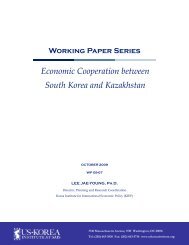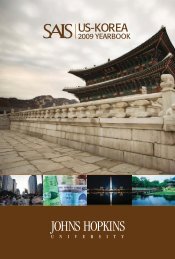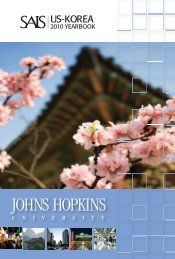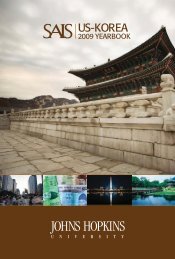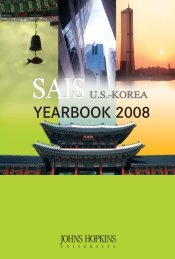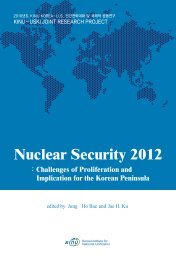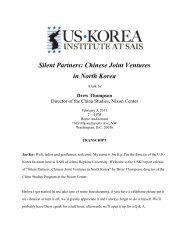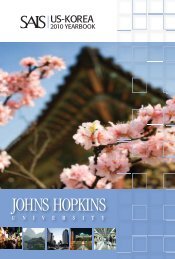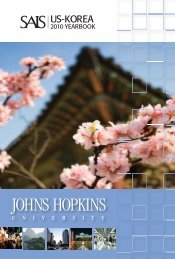US-Korea Institute at SAIS
US-Korea Institute at SAIS
US-Korea Institute at SAIS
- No tags were found...
You also want an ePaper? Increase the reach of your titles
YUMPU automatically turns print PDFs into web optimized ePapers that Google loves.
South <strong>Korea</strong>-China Mutual Perceptions: The Good, The Bad, and The Ugly<br />
SOUTH KOREA-CHINA MUTUAL PERCEPTIONS:<br />
THE GOOD, THE BAD, AND THE UGLY<br />
By Tze Chin “Alvin” Wong<br />
I. INTRODUCTION<br />
China’s and South <strong>Korea</strong>’s bil<strong>at</strong>eral political and economic rel<strong>at</strong>ions have<br />
developed dram<strong>at</strong>ically since the normaliz<strong>at</strong>ion of diplom<strong>at</strong>ic ties in 1992.<br />
China’s and South <strong>Korea</strong>’s leaders had effective political cooper<strong>at</strong>ion in bil<strong>at</strong>eral<br />
and multil<strong>at</strong>eral settings, such as ASEAN 10+3 and China-Japan-South <strong>Korea</strong><br />
tril<strong>at</strong>eral conferences; China and South <strong>Korea</strong> share a confluence of interests in<br />
regional security, such as the Six-Party Talks on the North <strong>Korea</strong>n nuclear issue.<br />
Indeed, China and South <strong>Korea</strong> have shared a consensus engagement of North<br />
<strong>Korea</strong> compared to other parties such as the United St<strong>at</strong>es and Japan, especially<br />
on the need to supply aid to DPRK and the aversion to apply sanctions. Since<br />
1992, trade and economic ties have mushroomed and formed the firm found<strong>at</strong>ion<br />
for bil<strong>at</strong>eral rel<strong>at</strong>ions. In view of this strong political and economic rel<strong>at</strong>ionship,<br />
China and South <strong>Korea</strong> have developed extensive people-to-people exchanges,<br />
with tourism, educ<strong>at</strong>ion, and culture flourishing since then. However, irritants<br />
and friction reflected in disputes over trade rel<strong>at</strong>ions, historical issues, territorial<br />
sovereignty, and cultural ownership, emerged over this period as well, <strong>at</strong> both<br />
the official and people-to-people levels. This resulted in heightened anxieties<br />
and insecurities, as demonstr<strong>at</strong>ed by rising neg<strong>at</strong>ive sentiment on both sides.<br />
Such neg<strong>at</strong>ive emotions <strong>at</strong> the public level could affect political and economic<br />
decisions by political elites and policymakers in the future, or <strong>at</strong> least constrain<br />
their room to maneuver, despite the consensus and commitment by leaders of<br />
both sides to maintain good bil<strong>at</strong>eral rel<strong>at</strong>ions.<br />
Unraveling this tangled web of complex political, economic, cultural, and<br />
historical issues became even more challenging, however, since most Chinese<br />
and South <strong>Korea</strong>n public opinion regarding each other was expressed mainly<br />
in the unbridled medium of cyberspace. Most scholars have examined Chinese-<br />
South <strong>Korea</strong>n rel<strong>at</strong>ions from political, economic, str<strong>at</strong>egic, and security angles,<br />
and many research papers have highlighted the Goguryeo history issue as an<br />
11



